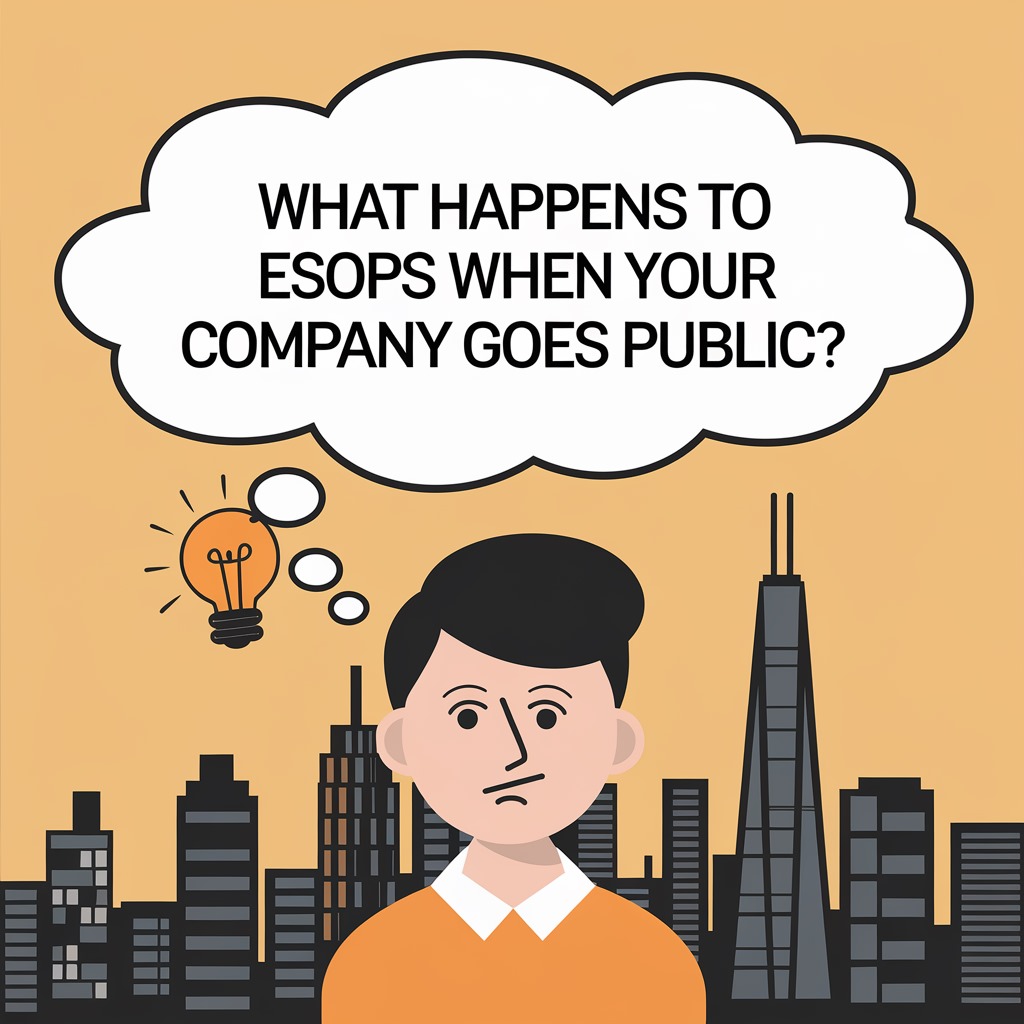As a founder, guiding your startup from its early stages to a successful IPO (Initial Public Offering) is one of the most significant milestones in your entrepreneurial journey. It’s a time of excitement, opportunity, and major transitions not just for you but for everyone involved in your company. One of the key areas of concern for your employees during this time will be what happens to their ESOPs when the company goes public.
If you’re gearing up for an IPO or even considering it in the future, understanding how ESOPs will be affected and preparing your team is crucial.
This blog will walk you through the essential points every founder needs to know about ESOPs during an IPO, how to communicate this effectively to your team, and how to maximise the benefits for your employees and your company.
What Are ESOPs?
In simple terms, ESOPs are a form of employee benefit that gives your employees the option to purchase company shares at a predetermined price. ESOPs are often granted as part of a compensation package designed to align the interests of employees with the long-term growth and success of the company.
When your company goes public, those ESOPs can become a valuable asset.
But what happens to them during and after the IPO process? Let’s break it down.
1. ESOPs Convert to Publicly Traded Shares
One of the most significant changes that happens when a company goes public is that ESOPs are converted into publicly traded shares. Before the IPO, these are private company shares that employees cannot freely trade or sell. However, after the IPO, employees can exercise their ESOPs, converting them into shares that can be traded on the stock market.
This process presents an exciting opportunity for employees to monetise their equity, but it also introduces complexities such as stock market volatility and trading windows. For founders, it’s crucial to ensure that employees understand the mechanics of this conversion and what it means for their financial future.
After an IPO, employees’ ownership through their ESOPs only has value when their options are exercised. Exercising just means that they buy the shares at the exercise price (the price at which the ESOPs were awarded). The difference between this price and the current market price post-IPO represents the potential profit (or loss).
2. Vesting Schedules
The employees are required to wait for their stock options to vest before exercising their ESOPs. Vesting schedules define at what time an employee is qualified to exercise their options. Normally, it vests in several years, and most commonly, it is four years with a one year cliff period. This means for an employee to be able to lay their hands on the shares, they must stay with the company for a given number of years.
Only vested ESOPs can be exercised. Any unvested options remain on hold until they meet the terms of the vesting schedule. As a founder, clarifying the vesting terms for your employees and making sure they understand what portion of their options can be exercised will help manage expectations.
3. Insider Trading Regulations
It’s important to note that in India, post IPO, there is no lock-in period specifically applicable to shares received through exercising ESOPs. However, employees should be informed that while they own publicly traded shares after exercising their options, they may still face restrictions if they are classified as insiders as per the Securities and Exchange Board of India (Prohibition of Insider Trading) Regulations, 2015 (“PIT Regulations”). Employees classified as insiders are those who have access to unpublished price-sensitive information (UPSI) as per the definition prescribed under the company’s code of conduct. UPSI includes any information related to the company that is not publicly available and could materially affect the company’s stock price. Insiders are prohibited from trading their shares in the company while possessing UPSI and are mandated to seek for pre-clearance from the compliance officer as appointed by the company before selling their shares.
4. Understanding Stock Price Volatility Post-IPO
Once the lock-up period ends, employees will be able to sell their shares, but they need to understand that stock price volatility is a real risk. After an IPO, the stock market can be unpredictable, and the share price may fluctuate for a variety of reasons, including company performance, market conditions, and broader economic factors.
Some employees may want to cash out quickly, while others may prefer to hold onto their shares in hopes of future growth. Offering financial guidance or resources during this time can help employees make informed decisions and avoid selling in a panic if stock prices drop.
5. Tax Implications: An Important Consideration
Exercising ESOPs and selling shares come with tax consequences that employees should be aware of. Depending on the timing of the sale, employees may be subject to capital gains tax, and the amount of tax owed can significantly impact their overall financial outcome. Post IPO, when employees sell their shares on a recognized stock exchange, they will incur Securities Transaction Tax (STT) in accordance with the Securities Transaction Tax Rules, 2004. Importantly, STT applies only to publicly traded shares. If employees were dealing with unlisted shares or private options, they would not incur STT on those transactions.
As a founder, if employees require an understanding of taxes or wish to minimise their taxes, the best solution is to allow them to work with tax advisors or financial planners. You should ensure that employees are fully informed about the tax laws before they trade or exercise their stock options, as it is in their best interest.
6. Communicating with Your Team
One of the most important things you can do as a founder during an IPO is to maintain open and transparent communication with your team. IPOs often cause excitement and anxiety among employees, leading to numerous questions about their ESOPs and when they can start selling their shares.
Organize Question and Answer sessions with your team, provide access to financial specialists, and offer regular updates on the IPO process. The more informed your employees are, the better equipped they will be to make decisions about their stock options, benefiting both them and the company.
Conclusion
For any founder, an IPO is a challenging process, but understanding how ESOPs are affected and maintaining clear communication with your team can ease many aspects of it. Ensure that your employees understand the value of their stock options, how to exercise them, and the associated costs. By being transparent and informative throughout the IPO process, you will foster trust and loyalty, ensuring that the company’s success is shared by all.
Looking to implement an ESOP and have questions about how to structure it effectively? Book a call with us using this link below for FREE guidance on this.


